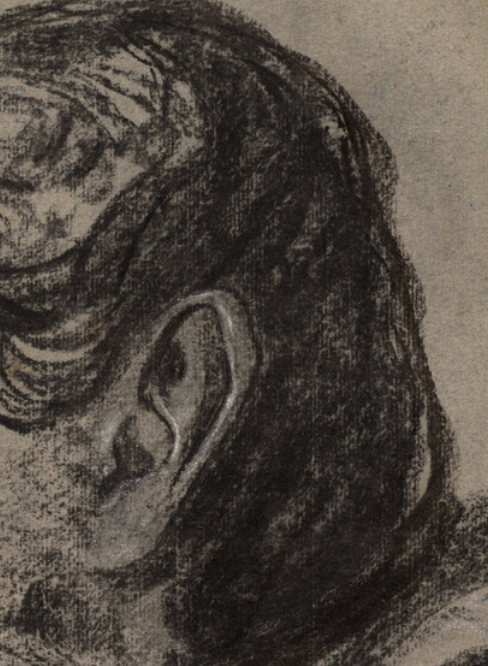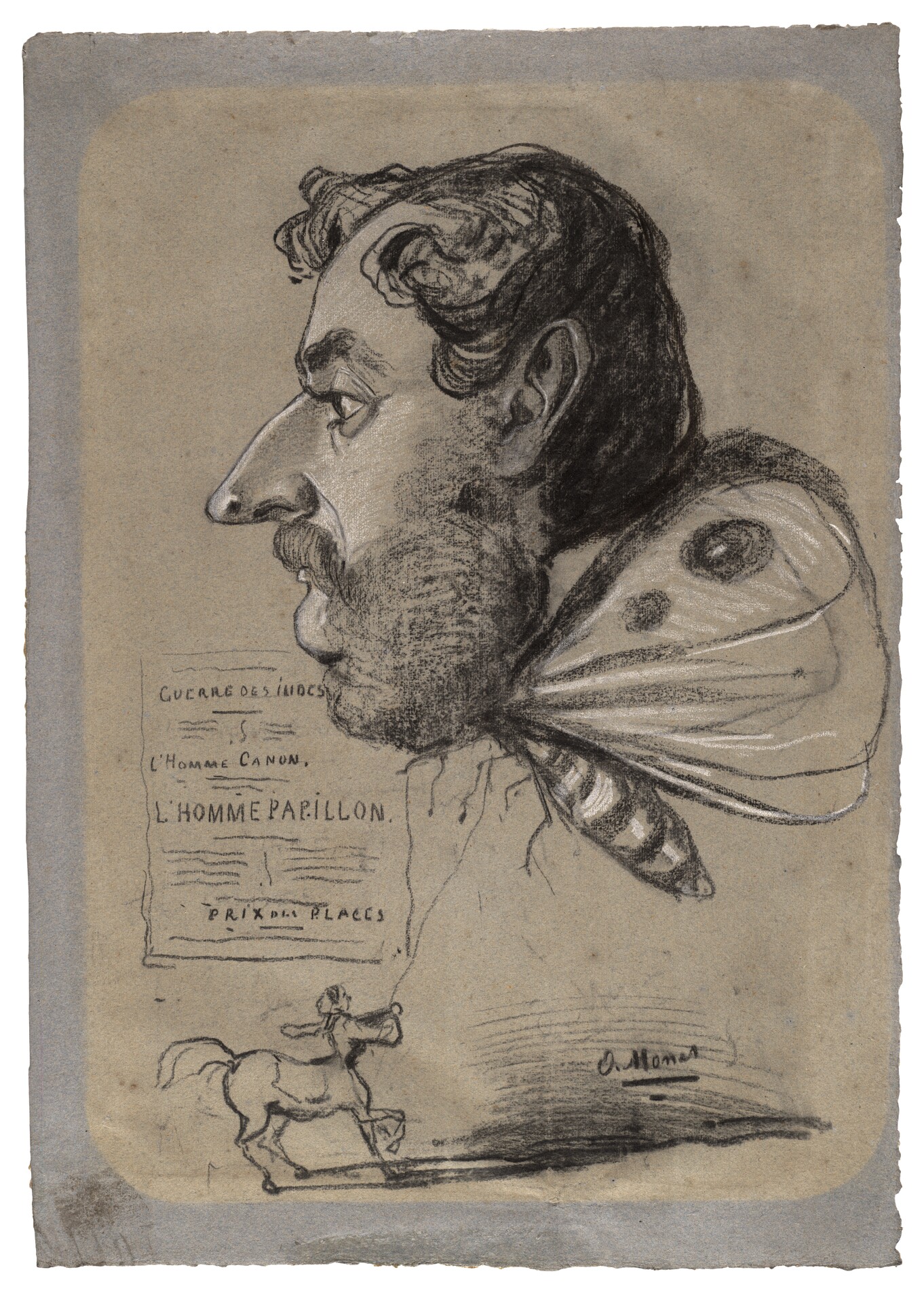Cat. 10
Caricature of Jules Didier (“Butterfly Man”)
c. 1858
Charcoal, heightened with white chalk, with smudging, on blue laid paper (discolored to light brown); 616 × 436 mm
The Art Institute of Chicago, Mr. and Mrs. Carter H. Harrison Collection, 1933.889
Technical Report
Technical Summary
Claude Monet created Caricature of Jules Didier with charcoal and touches of white chalk on moderately textured blue [glossary:laid] sheet. The paper color provides a middle tone for the composition, with touches of white chalk added as highlights on the face and the insect body and wings. It appears that the artist first worked out the man’s face with light, quick strokes of charcoal and then further developed it with darker, broader lines and shading. In contrast to the complex rendering of the face, the insect’s body and wings are more generally established.
Signature
O. Monet (recto, lower right corner, in charcoal).
O. Monet (recto, partially removed, lower right corner, in charcoal).
Media and Support
Support Characteristics
Primary paper type
Blue, thick, moderately textured [glossary:laid] paper.
Watermark
MFDT, near the bottom left corner, vertical.
Chain line orientation and frequency
Horizontal, 28–29 mm
Laid line frequency
90–100 mm
Furnish
Ivory, dark-blue, medium-blue, and red fibers.
Formation
Slightly uneven; in transmitted illumination this handmade paper has many circular thinned areas (often referred to as papermaker’s tears) and clumps of fiber.
Other characteristics
The sheet has four [glossary:deckle edges].
Dimensions
616 × 436 mm
Preparatory Layers
No artistic surface alterations or coatings are visible in normal conditions, under [glossary:UV] illumination, or under magnification. Under UV illumination, there is a pale-yellow visible-light [glossary:fluorescence] overall on the paper surface that is characteristic of a light gelatin surface [glossary:sizing].
Media Characteristics
The composition was drawn using the tip or edge of a thick charcoal stick to establish the face and the form of the insect body and wings. Some of the charcoal lines have a brownish-black tonality, such as at the back of the man’s head (fig. 10.1). Tonal effects were achieved using the edge of the charcoal stick with straight lines, whether vertical, horizontal, or diagonal. Monet created the extended sideburns using the side of the charcoal in a circular motion. In contrast, the figure’s locks of hair were rendered with long, wavy lines using the tip of the charcoal stick. There are a few areas of smudging of the charcoal along the nose, the bags under the eyes, and the chin, although it is unclear whether this was intentional or rather the unavoidable blending of the media from application. Touches of white chalk were used to highlight areas in the face and on the insect body and wings. The artist used the tip of a thick white chalk to render diagonal and horizontal lines that create tonal effects.
Compositional Development
The composition was drawn directly onto the paper [glossary:support]. There is minor reworking of the figure’s head, the tip of the nose, and the brow line. There are several strokes in these areas that indicate that the artist was reworking the subject’s profile. These areas were built up slightly, and the nose tip has a minor amount of smudging.
Surface Treatment
No fixatives or coatings are visible in normal conditions, under UV illumination, or under magnification.
Condition History
The drawing is in good condition. The sheet has faded overall in the window opening on the recto. There is no fading noted on the verso. The sheet was perimeter mounted to a secondary support with a water-soluble adhesive. Much of the adhesive and paper residues remain on the verso, with a small patch of adhesive on the recto at the center of the bottom edge. With UV-induced visible fluorescence, the adhesive fluoresces pale blue. There are several brown [glossary:foxing] spots throughout the sheet on the recto and verso. With UV-induced visible fluorescence, several foxing spots that were not visible in normal illumination are visible because the paper sizing does not fluoresce. There is a thin band of paper abrasion at the center of the upper edge. There are several tears along the right edge along with another small tear near the top left corner. The tears were repaired using a white [glossary:Japanese paper] with water-soluble adhesive on the verso. There are two areas of paper [glossary:skinning] with associated tears and losses at the bottom edge. The first skinned area is located at the center of the bottom edge, approximately 160 mm from the right edge. The paper was set down and flattened, but the tears were not realigned, leaving visible the blue fibers from the verso. The other area of skinning is much smaller and better realigned. It is located 40 mm from the left edge and 73 mm from the bottom edge. Both skinned areas were reinforced on the verso with a white paper and a water-soluble adhesive. The media are in good condition; there is a vertical band of smudging extending from the center of the subject’s hair down to the legs of the insect body. There is stray black media at the lower left corner.
Dawn Jaros
Provenance
Alfred Dusseuil (1878–1927), Paris.
Sold by Henri Cottereau, Paris, to Carter H. Harrison (1860–1953), Chicago, winter 1927–28.
Given by Carter H. Harrison to the Art Institute of Chicago, 1933.
Exhibition History
New York, Wildenstein and Company, A Loan Exhibition of Paintings by Claude Monet for the Benefit of the Children of Giverny, Apr. 11–May 12, 1945, p. 58, cat. 81.
Art Institute of Chicago, The Carter H. Harrison Memorial Exhibition, Nov. 19, 1954–Feb. 1, 1955, checklist no. 27.
Art Institute of Chicago, Claude Monet: 1840–1926, July 22–Nov. 26, 1995, p. 23, cat. 1c (ill.).
Williamstown, Mass., Sterling and Francine Clark Art Institute, The Unknown Monet: Pastels and Drawings, June 24–Sept. 16, 2007, pp. 49–51, fig. 52; 53; 300; London, Royal Academy, Mar. 17–June 10, 2007.
Selected References
Hugh Edwards, “The Caricatures of Claude Monet,” Bulletin of the Art Institute of Chicago, 37, 1 (Jan. 1943), pp. 71–72 (ill.).
Charles Merrill Mount, Monet, a Biography (Simon & Schuster, 1966), pp. 33; following p. 190 (ill.); 396.
Daniel Wildenstein, Claude Monet (Fratelli Fabbri, 1971), pp. 84, 93, no. 52 (ill.).
Rodolphe Walter, “Claude Monet as a Caricaturist: A Clandestine Apprenticeship,” trans. Eric Young, Apollo 103 (June 1976), p. 489.
Harold Joachim and Sandra Haller Olsen, French Drawings and Sketchbooks of the Nineteenth Century, vol. 2 (University of Chicago Press, 1979), p. 72, no. 4B8.
Ralph E. Shikes and Steven Heller, The Art of Satire: Painters as Caricaturists and Cartoonists from Delacroix to Picasso (Pratt Graphics Center/Horizon, May 1, 1984), p. 30 (ill.).
Daniel Wildenstein, Claude Monet: Catalogue raisonné, vol. 5, Supplément aux peintures: Dessins; Pastels; Index (Wildenstein Institute, 1991), p. 151, cat. D515 (ill.).
Andrew Forge, Monet, Artists in Focus (Art Institute of Chicago, 1995), pp. 8; 9, fig. 1.
Margaret A. Sullivan, “Caricature/Cartoon,” in Encyclopedia of Comparative Iconography, vol. 1, ed. Helene E. Roberts (Dearborn, 1998), p. 162.
Alison Syme, A Touch of Blossom: John Singer Sargent and the Queer Flora of Fin-de-Siècle Art (Pennsylvania State University Press, 2010), pp. 4; 5, fig. 3.
Other Documentation
Inscriptions and Distinguishing Marks
Recto
Inscription
Location: center, left edge
Method: charcoal
Content: GUERRE DES iUDCS / L’HOMME CANON. / L’HOMME PAPILLON. / PRIX DES PLACES
Verso
Stamp
Location: center
Method: brown ink
Content: The Art / Institute of / Chicago
Mark
Location: lower left edge
Method: [glossary:graphite]
Content: 33.889
Examination Conditions and Technical Analysis
Raking Visible Light
Paper support characteristics identified.
Transmitted Visible Light
Paper mold characteristics identified.
Ultraviolet-Induced Visible Fluorescence (365 nm)
Pale-yellow fluorescence observed throughout along with pale-blue fluorescence of the adhesive.
Binocular Microscopy (80–100x)
Media type/application identified.
Image Inventory
The image inventory compiles records of all known images of the artwork on file in the Imaging Department and in the conservation and curatorial files in the Department of Prints and Drawings at the Art Institute of Chicago (fig. 10.2).


